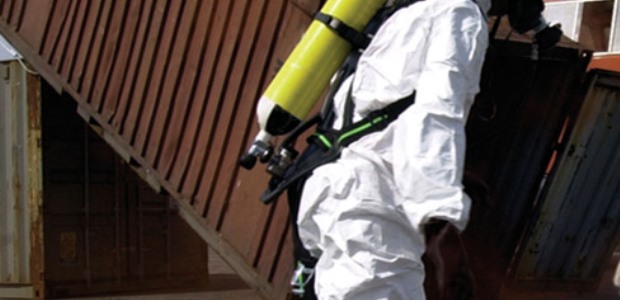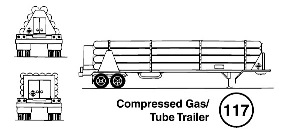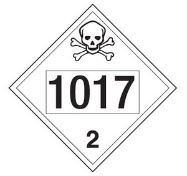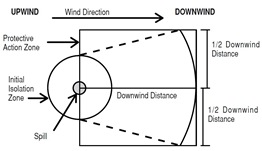
Handling Hazardous Material Emergencies
"Every good emergency vehicle will have binoculars in the cab so the responder does not have to get too close to the hazard but can see the vehicle and its markings."
Jerry Laws came in and said, "Barry, I was just talking to emergency response folks, and they were telling me about UN guide numbers identifying hazardous materials. But what about when an emergency gets out of hand--what do they do?"
"Jerry, it is easy to understand," I replied. "Let me explain it to you. The Department of Transportation publishes an orange book every four years called the Emergency Response Guidebook, or the ERG. They distribute a copy to every emergency service vehicle in the United States. The rest of us have to buy the book from any of several book publishers or can download it for free off the Internet.” (http://tinyurl.com/ERG2012)1
"The book is divided into six sections – a white-edged-pages section, one with yellow edges, blue edges, orange edges, green edges, and another white-edged section. If you get involved in chemical emergencies, read the two white sections and get to understand how to use this book, now--before you have an emergency and need to use it in a hurry.
"Let's start with the back white-edged section (page 356). Here you'll find the instructions in how to use this book during an emergency, protective clothing information, fire and spill control information, BLEVE2 table, information about CBRNE3, IED4 Stand-off distances, and it concludes with a glossary of terms."
OOkay, but how do you use it?" Jerry asked.
I replied, "Let's say that you're going down the road and you see a trailer that looks like the drawing below."
 "And it has this white label with a skull and crossbones. If this truck got into an accident, what is the material and how do the emergency service personnel deal with the release? If we didn't have the skull and bones sign --called a placard under DOT terminology--we could not identify the exact chemical, but knowing the shape of the transport vehicle tells us something about its contents.
"And it has this white label with a skull and crossbones. If this truck got into an accident, what is the material and how do the emergency service personnel deal with the release? If we didn't have the skull and bones sign --called a placard under DOT terminology--we could not identify the exact chemical, but knowing the shape of the transport vehicle tells us something about its contents.
 Pages 8 and 9 show us drawings of the various types of transport vehicles. We see the above drawing on page 9, and the 117 in a circle is the ERG guide number, or the orange-edged pages. Turning to guide 117 tells us that the material is a gas that could be toxic, flammable, and is extremely hazardous.
Pages 8 and 9 show us drawings of the various types of transport vehicles. We see the above drawing on page 9, and the 117 in a circle is the ERG guide number, or the orange-edged pages. Turning to guide 117 tells us that the material is a gas that could be toxic, flammable, and is extremely hazardous.
"Let's say that we have a non-descript vehicle but we can see the placards; we can use it just like we did with the vehicle shapes. You remember that there are nine DOT hazard classes, don't you?" I said.
"Yes," said Jerry, "I remember that."
"Unfortunately, there are more than nine placards," I continued. "If you look at pages 6 and 7, you can see examples of all of the various placards and markings used in shipping hazardous materials. Each classification has different hazards that emergency responders have to be aware of. For example, hazard class 1 is the explosive materials that include fireworks, blasting caps, and dynamite. Responders need to know that some class 1 materials could be shock sensitive (blasting caps), while other materials can be moved readily without fear of something going bang!
"Every good emergency vehicle will have binoculars in the cab so the responder does not have to get too close to the hazard but can see the vehicle and its markings. Do not forget the responders have a rule of thumb: It states that you fully extend your arm with your thumb up. If your thumb does not cover the emergency, you are too close. Move back! Having the binoculars helps them do that.
 "Since we do have a placard and it has a number, we turn to the yellow-edged pages and look for number 1017. This is the United Nations (UN) Guide number. Finding 1017 on page 21, we find that the material in the truck is chlorine. In this case, we only have one chemical. Look up UN 1075--another gas. How many chemicals are listed?5
"Since we do have a placard and it has a number, we turn to the yellow-edged pages and look for number 1017. This is the United Nations (UN) Guide number. Finding 1017 on page 21, we find that the material in the truck is chlorine. In this case, we only have one chemical. Look up UN 1075--another gas. How many chemicals are listed?5
"Getting back to the chlorine, we see that for UN1017, the guide number is 124. Turning to that guide, it tells us that the material is a gas that is toxic and/or corrosive and possibly oxidizing. You see that guides 117 and 124 are very similar in description. The specific details are slightly different for the two guides due to the unknown nature in 117 and the specific information in 124."
Jerry asked, "But what about the blue-edged pages?"
"You use those when you know the chemical's name," I explained. "That listing will give you UN number and the guide number."
"And why are some of the entries highlighted?"
"Those are gaseous chemicals that are toxic by inhalation. Chlorine6 for example, is highlighted in green, and you go to the back and the green-edged pages. You are given recommendations for isolation distances and then, depending upon the size of the release (small or large) and whether it is day or night, there are other recommendations for additional evacuation or protection distances.
"That in a nutshell is how to use the emergency response guidebook, but you need to remember that the ERG is not a definitive reference--it is a guide. The new Safety Data Sheets that have replaced the older MSDS may have more specific information, as does the information that is given by CHEMTREC, CHEMTEL, Inc., and some of the other emergency telephone service companies."
Jerry smiled. "I think I understand now," he said.
References
1. (The full URL is: http://phmsa.dot.gov/pv_obj_cache/pv_obj_id_7410989F4294AE44A2EBF6A80ADB640BCA8E4200/filename/ERG2012.pdf)
2. BLEVE is Boiling Liquid Expanding Vapor Explosion.
3. CBRNE is Chemical, Biological, Radiological, Nuclear and Explosive materials used by terrorists.
4. IED is Improvised Explosive Devices.
5. There are 12 chemicals listed for UN1075.
6. The proper shipping name for chlorine is: UN 1017, Chlorine, 2.3 (5.1, 8), Marine Pollutant. In addition, you may need more identification, depending upon the quantity being shipped.
This article originally appeared in the July 2014 issue of Occupational Health & Safety.